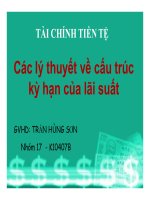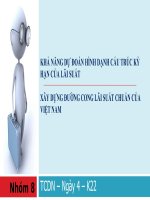Thuyết trình môn đầu tư tài chính cấu trúc kỳ hạn của lãi suất
Bạn đang xem bản rút gọn của tài liệu. Xem và tải ngay bản đầy đủ của tài liệu tại đây (2.43 MB, 61 trang )
L/O/G/O
TheTerm
TermStructure
Structure
The
of
Interest
Rates
of Interest Rates
GVHD: TS. TRẦN THỊ HẢI LÝ
1. Châu Thúy Duy
2. Nguyễn Phi Điệp
3. Lê Thị Thu Hà
4. Nguyễn Thành Tân
5. Lê Thị Thanh Thúy
www.trungtamtinhoc.edu.vn
THE TERM STRUCTURE OF INTEREST RATES
1. Explore the pattern of interest rates for different-term assets,
2. Identify the factors that account for that pattern,
3. Determine what information may be derived from an analysis of the so-called term structure of interest rates , the structure of
interest rates for discounting cash flows of different maturities,
4. Treasury bond Pricing
5. Examine the extent to which the term structure reveals market-consensus forecasts of future interest rates
6. How the presence of interest rate risk may affect those inferences
7. Use the term structure to compute forward rates that represent interest rates on “forward,” or deferred, loans, and consider the
relationship between forward rates and future interest rates.
www.trungtamtinhoc.edu.vn
15.1 THE YIELD CURVE
Figure 14.1 demonstrated that bonds of different maturities typically sell at different
yields to maturity:
- When these bond prices and yields were compiled, long-term bonds sold at higher
yields than short-term bonds.
- Practitioners commonly summarize the relationship between yield and maturity
graphically in a yield curve
www.trungtamtinhoc.edu.vn
15.1 THE YIELD CURVE
www.trungtamtinhoc.edu.vn
15.1 THE YIELD CURVE
The yield curve is central to bond valuation and, as well, allows investors togauge their
expectations for future interest rates against those of the market
www.trungtamtinhoc.edu.vn
15.1 THE YIELD CURVE
Bond Pricing
-
The yield curve is central to bond valuation
-
If yields on different-maturity bonds are not all equal, how should we value coupon
bonds that make payments at many different times?
www.trungtamtinhoc.edu.vn
15.1 THE YIELD CURVE
Bond Pricing
-
Recall the Treasury STRIPS program we introduced in the last chapter (Section 14.4). Stripped
Treasuries are zero-coupon bonds created by selling each coupon or principal payment from a
whole Treasury bond as a separate cash flow.
-
If each cash flow can be (and in practice often is) sold off as a separate security, then the value
of the whole bond should be the same as the value of its cash flows bought piece by piece in
the STRIPS market. What if it weren’t? Then there would be easy profits to be made
www.trungtamtinhoc.edu.vn
15.1 THE YIELD CURVE
Bond Pricing
Example 15.1 Valuing Coupon Bonds:
-
Suppose the yields on stripped Treasuries are as given in Table 15.1, 10% coupon bond with a
maturity of 3 years
-
The $100 coupon paid at the end of the first year
The second cash flow, the $100 coupon at the end of the second year
The final cash flow consisting of the final coupon plus par value, or $1,100.
www.trungtamtinhoc.edu.vn
15.1 THE YIELD CURVE
Bond Pricing
The value of the coupon bond is:
www.trungtamtinhoc.edu.vn
15.1 THE YIELD CURVE
Bond Pricing
-
The yield to maturity of the coupon bond in Example 15.1 is 6.88%; so while its maturity matches that of the 3-year zero in
Table 15.1 , its yield is a bit lower.
-
This reflects the fact that the 3-year coupon bond may usefully be thought of as a portfolio of three implicit zero-coupon
bonds, one corresponding to each cash flow.
-
The yield on the coupon bond is then an amalgam of the yields on each of the three components of the “portfolio.”
=> If their coupon rates differ, bonds of the same maturity generally will not have the same yield to maturity
www.trungtamtinhoc.edu.vn
15.1 THE YIELD CURVE
Bond Pricing
What then do we mean by “the” yield curve?
-
The pure yield curve refers to the curve for stripped, or zero-coupon, Treasuries
-
The on-the-run yield curve refers to the plot of yield as a function of maturity for
recently issued coupon bonds selling at or near par value.
www.trungtamtinhoc.edu.vn
15.1 THE YIELD CURVE
Bond Pricing
CONCEPT CHECK 15.1:
Calculate the price and yield to maturity of a 3-year bond with a coupon rate of
4% making annual coupon payments
www.trungtamtinhoc.edu.vn
15.1 THE YIELD CURVE
Bond Pricing
CONCEPT CHECK 15.1:
Does its yield match that of either the 3-year zero or the 10% coupon bond
considered in Example 15.1? Why is the yield spread between the 4% bond and
the zero smaller than the yield spread between the 10% bond and the zero?
www.trungtamtinhoc.edu.vn
15.2 The Yield Curve and Future Interest Rates
The Yield Curve under Certainty
Content
Holding-Period Returns
Forward Rates
14
www.trungtamtinhoc.edu.vn
The Yield Curve under Certainty
we will begin with an admittedly idealized framework, and then extend the discussion to
more realistic settings. To start, consider a world with no uncertainty, specifically, one in
which all investors already know the path of future interest rates.
If interest rates are certain, what should we make of the fact that the yield on the 2-year zero
coupon bond in Table 15.1 is greater than that on the 1-year zero?
15
www.trungtamtinhoc.edu.vn
The Yield Curve under Certainty
To answer this question, consider two 2-year bond strategies:
1.
Buying the 2-year zero offering a 2-year yield to maturity of y 2 = 6% and holding it until maturity
The zero with face value $1,000 is purchased today for $1.000 / 1,06
$1.000 / $890 = 1,06
2
2
= $890. The total 2-year growth factor for the investment is therefore
= 1,1236.
2. Buying the 1-year zero offering a 1-year yield to maturity of y 2 = 5% and reinvest the proceeds in another 1-year bond with r 2
Buy and hold 2-year zero = Roll over 1-year bonds
2
$890 x 1,06 = $890 x 1,05 x (1 + r2)
r2 = 7,01%
we see that it has a compensating advantage: It allows you to roll over your funds into another short-term bond next year when rates will be
higher
16
www.trungtamtinhoc.edu.vn
The Yield Curve under Certainty
17
www.trungtamtinhoc.edu.vn
The Yield Curve under Certainty
The spot rate: the yield to maturity on zero-coupon bonds , meaning the rate
that prevails today for a time period corresponding to the zero’s maturity. In our
example, The spot rate is 6%
The short rate:to the interest rate for that interval available at different points
in time. In our example, the short rate today is 5%, and the short rate next year
will be 7.01%.
18
www.trungtamtinhoc.edu.vn
The Yield Curve under Certainty
the 2-year spot rate is an average of today’s short rate and next year’s short rate. But because of compounding, that
average is a geometric one. We see this by again equating the total return on the two competing 2-year strategies:
2
(1 + y2) = (1 + r1) x (1 + r2)
1 + y2 = [(1 + r1) x (1 + r2)]
1/2
When next year’s short rate, r2 , is greater than this year’s short rate, r 1, the average of the two rates is higher than
today’s rate, so y2 . r1 and the yield curve slopes upward. If next year’s short rate were less than r 1 , the yield
curve would slope downward.
Thus, at least in part, the yield curve reflects the market’s assessments of coming interest rates
19
www.trungtamtinhoc.edu.vn
Holding-Period Returns
the multiyear cumulative returns on all of our competing bonds ought to be equal. What about
holding-period returns over shorter periods such as a year? You might think that bonds selling at
higher yields to maturity will offer higher 1-year returns
20
www.trungtamtinhoc.edu.vn
Holding-Period Returns
The 1-year bond in Table 15.1 can be bought today for $1.000/1,05 = $952,38 and will mature to its par value in 1
year. It pays no coupons, so total investment income is just its price appreciation, and its rate of return is ($1.000
- $952,38) / $952,38 = 0,05.
The 2-year bond can be bought for $1.000/1,06
2
= $890. Next year, the bond will have a remaining maturity of 1
year and the 1-year interest rate will be 7,01%. Therefore, its price next year will be $1.000/1,0701 = $934,49, and its
1-year holding-period rate of return will be ($934,49 - $890)/$890 = 0,05, for an identical 5% rate of return .
www.trungtamtinhoc.edu.vn
Forward Rates
•
The following equation generalizes our approach to inferring a future short rate from the yield curve of zerocoupon bonds. buying and holding an n -year zero-coupon bond versus buying an ( n -1)-year zero and rolling
over the proceeds into a 1-year bond.
n
n -1
(1 + yn) = (1 + yn - 1)
x (1 + rn)
•
22
www.trungtamtinhoc.edu.vn
Forward Rates
•
If the forward rate for period n is denoted f n , we then define fn by the equation
Equivalently, we may rewrite Equation as
In this formulation, the forward rate is defined as the “break-even” interest rate that equates the return on an n
-period zero-coupon bond to that of an ( n - 1)-period zero-coupon bond rolled over into a 1-year bond in year n.
The actual total returns on the two n -year strategies will be equal if the short interest rate in year n turns out to
equal fn.
www.trungtamtinhoc.edu.vn
Excel APPLICATIONS: Spot and
Forward Yields
•
The spreadsheet below can be used to estimate prices and yields of coupon bonds
and to calculate the forward rates for both single-year and multiyear periods.
•
The spot rates for each maturity date are used to calculate the present value of
each period’s cash flow. The sum of these cash flows is the price of the bond. Given
its price, the bond’s yield to maturity can then be computed
www.trungtamtinhoc.edu.vn
Excel APPLICATIONS: Spot and
Forward Yields
www.trungtamtinhoc.edu.vn









